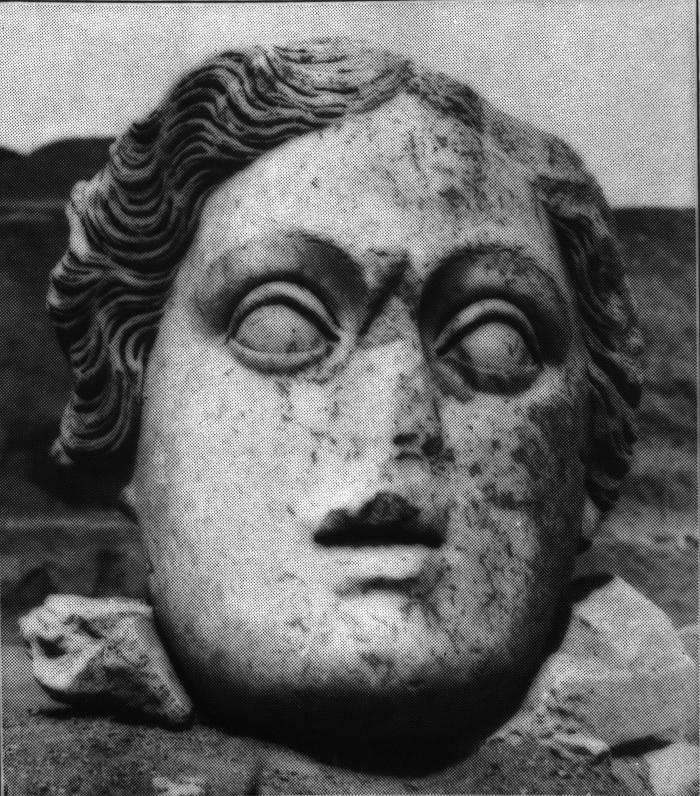-
 Stele of Menophila
Stele of MenophilaR2 Cat. 245
Sculpture
Marble, Stone
2nd or 1st C. BC (Hellenistic)
The pediment has three acroteria: the central one has two snakes pointing downwards; the other two each have one snake pointing upwards. The recessed niche has tapering sides parallel to the stele sides. The relief shows a woman standing in a Pudicit...
-
 Statue of Moschine, Priestess of Artemis
Statue of Moschine, Priestess of ArtemisR2 Cat. 246
Sculpture
Marble, Stone
50-25 BC (Hellenistic)
The priestess stands twisted slightly to her l., her r. foot drawn back and resting on the toes. She wears a chiton, himation, and platformed sandals, and stands on a square inscribed base.
The himation is drawn from her r. to her l. side across her b...
-
 Winged Eros
Winged ErosR2 Cat. 247
Sculpture
Marble, Stone
Late 3rd C. BC (Hellenistic)
The nude, winged Eros, just older than a baby, stands with the weight on his r. leg, his head turned slightly to proper l. His r. arm is bent at the elbow and across the body. A small fragment of an arrow is held in his r. hand. The l. hand probably ...
-
 Triple Head of Hekate
Triple Head of HekateR2 Cat. 248
Sculpture
Marble, Stone
Roman? (Roman?)
The central head of the Hekateion has circular locks and a floral crown. The two lateral heads have ribbons in their hair which is parted in the center and falls in long locks on their shoulders. They wear turreted crowns. There are incised lines on ...
-
 Double-Sided Herm with Kouros Figure on One Side and Herm on the Other
Double-Sided Herm with Kouros Figure on One Side and Herm on the OtherR2 Cat. 249
Sculpture
Marble, Stone
1st or 2nd C. AD (Roman)
The kouros, treated as a frontal relief, stands with both feet together and both arms down the sides. A strand of hair remains on his r. shoulder. The neck, chest, and abdomen are outlined in a sharp, linear fashion. The pubic hair is somewhat styliz...
-
 Head of Augustus
Head of AugustusR2 Cat. 250
Sculpture
Marble, Stone
1st half of 1st C. AD (Roman)
The idealized head of Augustus is turned slightly to his I. The sharp lines for eyebrows are prominent; the large eyes have no markings for pupil or iris. The nose is sharp and pointed, the mouth small. The face is attractive, but remarkably lacking ...
-
 Head of the Elder Faustina
Head of the Elder FaustinaR2 Cat. 251
Sculpture
Marble, Stone
Ca. 140 AD (Roman)
The following description is after İnan-Rosenbaum: The back of the head is hollow and has a large dowel hole in the center flanked by two oblong dowel holes. Two other dowel holes at ear lobe level are broken away. There are drill channels in the hai...
-
 Colossal Female Head, Artemis?
Colossal Female Head, Artemis?R2 Cat. 252
Sculpture
Marble, Stone
Ca. 140 AD? (Antonine) (Roman)
The following description is taken from Sardis I, 147: "A colossal sculptured face, very well preserved . . . differs entirely from the similar heads found here; for, though in high relief, it was almost certainly never part of an entire head, but wa...
-
 Horseman Riding toward Altar
Horseman Riding toward AltarR2 Cat. 253
Sculpture
Marble, Stone
(Hellenistic)
The horseman, according to Buckler and Robinson, has a crescent behind his shoulders and therefore represents Mên (ibid.). He wears a short belted tunic with a few minimal diagonal folds. In his r. hand he may hold a short stick. The beginning of the...
-
 Head of a Woman
Head of a WomanR2 Cat. 254
Sculpture
Marble, Stone
AD 218-235 (Roman)
The portrait was worked for insertion into a statue body. The head is turned slightly to the l., and the woman looks upwards, as indicated by the drilled bean-shaped pupils which are placed high within the incised irises. The surfaces of the eyes are...
-
 Bust of Elpidike
Bust of ElpidikeR2 Cat. 255
Sculpture
Marble, Stone
3rd C. AD (Roman)
The bust of a woman is framed by an arched niche with a pilaster on each side, with simple capital and base. The head is turned slightly to the l. Her hair is parted in the middle and drawn behind her ears, where it falls in heavy locks. The drapery,...
-
 Enthroned Mother of the Gods (Cybele)
Enthroned Mother of the Gods (Cybele)R2 Cat. 256
Sculpture
Marble, Stone
2nd or 3rd C. AD (Roman)
Cybele is enthroned and seated between two lions. The arched recess in which she sits suggests a shrine. She wears a high-girt chiton with a V-neck. The transparent cloth reveals her navel and the shape of her breasts. A heavier cloth himation is dra...